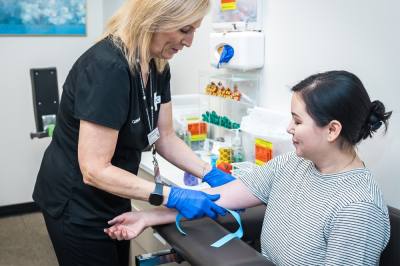“I am passionate about helping and empowering women through their health care, from adolescence to childbirth to menopause,” Christine E. Glass, MD, Ob/Gyn at ARC Medical Plaza Specialty in Cedar Park said. “The Ob/Gyn specialty allows for both a personal, problem-solving relationship as well as a continuity of preventive care throughout a woman’s life. I take time to listen to my patients and believe in shared decision-making. I am grateful for the privilege of practicing medicine, and I work hard to teach and empower my patients with health care knowledge.”
When a patient decides that they want to have a baby, they should visit their Ob/Gyn before the pregnancy begins. Patients want to be able to plan ahead of time and fill in the gaps where they’re missing parts of their care, such as vaccinations.
The pre-pregnancy exam is a way for the doctor or APC to get to know the patient. They will investigate and find out if there is anything that needs attention before the pregnancy. They will do lab work to make sure that all levels are in the normal range, and also offer genetic testing if requested.
What the doctor may recommend
The recommendations that a doctor or APC may make are based on what is discussed during the pre-pregnancy visit and what they identify on the exam. For example, if a patient needs to gain weight or even lose weight, they will suggest safe ways to do so. They will also identify if there are any risk factors.
Questions patients may have
How long will it take for ovulation to normalize after stopping birth control?
The average time it takes a woman to conceive depends upon if she was on birth control. If a patient was on the birth control pill, it can take one to three months for the period to normalize. If the patient is on a long-acting reversible contraceptive method, such as Nexplanon, it can actually take up to six months. None of these contraceptive methods interfere with fertility.
When should a patient see their doctor if they have not conceived?
If the patient is over the age of 35 and it takes more than six months, they should consider returning to see their Ob/Gyn so that they can initiate the evaluation of why the patient is having difficulty. For those under the age of 35, it is recommended that the patient visit their Ob/Gyn after a full year of trying to conceive.
Along with all the many considerations parents have, like financial readiness, finding the right Ob/Gyn, pediatrician and child care, there are a few less common issues to consider. Specifically, checking for genetic issues, thinking about saving cord blood and understanding the risks of prenatal diabetes.
Genetic screenings
Genetic screening is a medical test that examines an individual's DNA to identify gene changes or mutations.
This process helps assess the risk of passing on genetic disorders to future generations and typically involves the following steps:
- Sample collection: A sample of DNA is collected, often through a blood sample, saliva or a cheek swab.
- Laboratory analysis: The collected DNA sample is analyzed in a laboratory to identify any genetic variations or mutations. This analysis may include examining specific genes or regions of the genome.
- Interpretation of results: The results are interpreted by health care professionals to determine whether there are any genetic abnormalities or an increased risk of certain genetic conditions.
Genetic screening offers valuable information but can raise ethical, social and psychological considerations for some. Consult a physician to understand results and make informed decisions on potential actions or interventions.
Cord blood banking
Cord blood banking involves collecting and storing the blood from the umbilical cord of a newborn baby. The blood from the umbilical cord is rich in stem cells, which can be used in medical treatments. These stem cells have the potential to develop into various types of cells, such as blood, immune system and bone cells.
The process typically involves the following steps:
- Collection: After the baby is born and the umbilical cord is clamped and cut, the remaining blood in the cord is collected using a special bag.
- Processing: The collected blood is then processed to isolate and store the stem cells. The stem cells can be preserved at low temperatures for an extended period.
- Storage: The processed cord blood is stored in a cord blood bank, either a public bank or a private bank. Public banks make cord blood available for anyone in need, while private banks store it exclusively for the family.
Cord blood is a valuable source of stem cells that can be used to treat a variety of medical conditions, including cancers, blood disorders and immune system deficiencies. By banking cord blood, parents ensure a potential source of treatment for their child or other family members in the future. The collection process is noninvasive and poses no risks to the mother or the baby.
Gestational diabetes
Gestational diabetes is a type of diabetes that occurs during pregnancy. It can affect the mother's health and increase the risk of complications for the baby.
Complications may include:
- Increased risk of Type 2 diabetes in the mother: Women who have had gestational diabetes have a higher risk of developing Type 2 diabetes later in life.
- Increased risk of obesity and Type 2 diabetes in the child: Children born to mothers with gestational diabetes may have a higher risk of obesity and Type 2 diabetes later in life.
- Higher birth weight: Babies born to mothers with uncontrolled gestational diabetes may be larger than average, increasing the risk of complications during delivery.
- Low blood sugar in newborns: After birth, the baby may experience low blood sugar levels because their insulin production increases in response to the mother's high blood sugar levels.
- Respiratory distress syndrome: Babies born to mothers with gestational diabetes may be at a higher risk of respiratory distress syndrome.
One step in ensuring a healthy pregnancy involves regular prenatal care visits. Each and every visit plays a crucial role in monitoring the well-being of both the expectant mother and the developing baby.
“I strive to create an environment in which patients feel heard and supported so that I may best help them make decisions for their health most consistent with their desires and values,” Christopher S. Cowden, MD, MPH, Ob/Gyn at ARC Center Street in Kyle said.
How soon should patients see an Ob/Gyn for a prenatal care visit?
One of the first steps toward a healthy pregnancy is scheduling the first prenatal care appointment with an Ob/Gyn. Ideally, this should be done as soon as a patient discovers they are pregnant. Early prenatal care is associated with numerous benefits, including the identification and management of potential issues, creating a solid foundation for a healthy pregnancy.
What happens during the first prenatal visit?
The first prenatal care visit is a crucial milestone, setting the tone for the entire pregnancy. The visit typically involves a comprehensive discussion about health, medical history, and lifestyle. The Ob/Gyn will cover topics such as pregnancy history, underlying health conditions, medications and any other concerns. Physical examinations, including a pelvic exam, pap smear and blood tests, may also be conducted to assess overall health.
How often are prenatal care visits typically scheduled?
The frequency of prenatal care visits is often determined by the trimester and whether it is a low-risk or high-risk pregnancy. In the first trimester, monthly visits are common, increasing to biweekly or weekly as the due date approaches. High-risk pregnancies may require more frequent monitoring to address specific concerns and ensure the well-being of both mother and baby.
ARC Ob/Gyn doctors and APCs are primary care specialists who focus on women's health issues, including pregnancy, fertility, birth control, mammograms, menopause, STD testing, ultrasounds and more.
Patients can make an appointment online with an ARC Ob/Gyn with MyChart, or by calling the clinic most convenient for them.
The above story was produced by Community Impact's Senior Multi Platform Journalist Sierra Rozen with information solely provided by the local business as part of its "sponsored content" purchase through our advertising team.

















